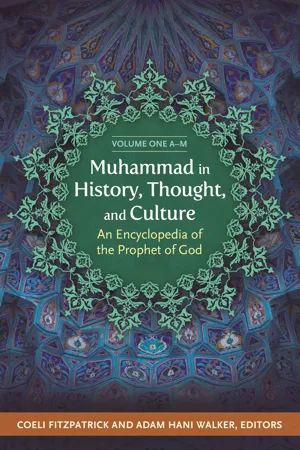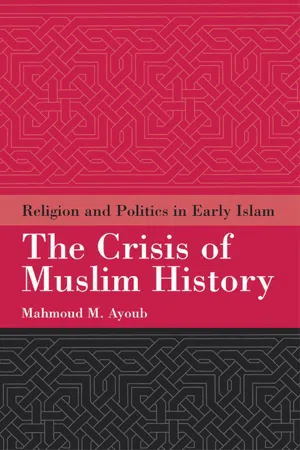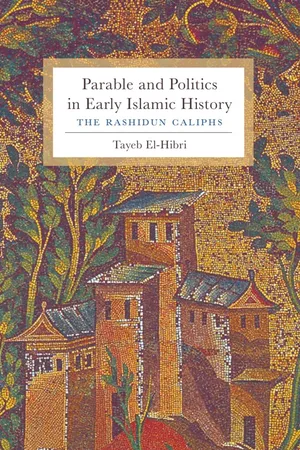History
Umar Ibn Khattab
Umar ibn Khattab was a prominent figure in early Islamic history, serving as the second caliph after the death of Prophet Muhammad. He is known for his just and effective leadership, expansion of the Islamic empire, and establishment of various administrative and judicial reforms. Umar's reign is often remembered for its emphasis on social justice, accountability, and good governance.
Written by Perlego with AI-assistance
Related key terms
5 Key excerpts on "Umar Ibn Khattab"
- eBook - ePub
Muhammad in History, Thought, and Culture
An Encyclopedia of the Prophet of God [2 volumes]
- Coeli Fitzpatrick Ph.D., Adam Hani Walker, Coeli Fitzpatrick Ph.D., Adam Hani Walker(Authors)
- 2014(Publication Date)
- ABC-CLIO(Publisher)
U
‘UMAR IBN AL-KHATTAB AL-FARUQ (586–644)
Khaled M. G. Keshk‘Umar ibn al-Khattab al-Faruq (r. 634–644), from the ‘Adi ibn Ka‘b clan of the Quraysh, was the second caliph of the Islamic community after the death of the Prophet. ‘Umar is one of the four Rashidun (“Rightly Guided”) caliphs and was known for his devotion to Islam and to the Prophet.‘Umar initially was one of the most fervent enemies of Islam and Muslims. Muslim sources relate how he converted to Islam after an aggressive confrontation with his sister and her husband, who had secretly become Muslims. ‘Umar had asked to hear the verses from the Qur’an that his sister was reciting, and upon hearing the beauty of the Arabic, he converted. This conversion, according to the sources, took place in and around 618/619, after which ‘Umar was in the vanguard of the new community (umma ) and became one of Muhammad’s closest advisers, second only to Abu Bakr. ‘Umar married his daughter, Hafsa, to the Prophet and participated in all the major battles against members of the Quraysh tribe, who still opposed the Prophet. ‘Umar seemed to be more of the hawk when it came to the Prophet’s policies with regard to the enemies of the umma .In 634 ‘Umar was appointed caliph by his predecessor, Abu Bakr. According to the sources, ‘Umar was the first to take on the title amir al-mu’minin (commander of the faithful/believers). In fact, new scholarship has shown that this was the title of the rulers a long time before the use of “caliph” came into play during the Umayyad period. As ruler, ‘Umar continued the conquests started by his predecessor and created institutions that not only affected the empire politically but also had profound religious ramifications.‘Umar’s first order of business was to relieve Khalid ibn al-Walid from his post as commander of the Muslim army in Syria. Some of the sources say that it was because Khalid, while in the field, bathed in wine, while others maintain that it was because of his growing ego that was being inflated by his remarkable victories. Whatever the reason, ‘Umar seems to have been the main reason for the early retirement of this great Muslim general. After three decisive battles in Ajnadayn, Fihl (Pella), and Yarmuk, in 637 the Byzantine Army and its Arab allies (Ghassan, Lakhm, and Judham) were soundly defeated by the Muslims. This opened up Syria (Palestine, Jordan, Lebanon) for the Muslims. In 638 the Muslim armies conquered Jerusalem, and it was ‘Umar himself who went up to Jerusalem and accepted the surrender of the patriarch. It was at this time that the foundations for the al-Aqsa mosque were laid out. - eBook - ePub
- Alexander Knysh(Author)
- 2016(Publication Date)
- Routledge(Publisher)
Figure 3.2 ).Figure 3.1 Illustration of the Entry of the Caliph ‘Umar into JerusalemGetty Images/Bettmann. Drawn by O. FikentsherFigure 3.2 Muhammad (Veiled), Accompanied by Abu Bakr and ‘AliBaldwin H. Ward & Kathryn C. Ward/CORBIS Rights ManagedUnlike the Prophet, ‘Umar could not claim to be a recipient of revelations from God, since they ceased with the death of the founder of Islam. However, as an early convert and a right-hand man of the Prophet, ‘Umar spent much time by his side and was intimately familiar with his habits, mentality, and decision making. ‘Umar’s familiarity with the Prophet’s “ways” gave him the authority to speak on the Prophet’s behalf and even to interpret God’s will. This situation was accepted by the vast majority of Muslims—at least, during ‘Umar’s tenure his authority was never directly questioned or called into doubt. In addition to his close association with the Prophet, ‘Umar’s leadership rested on his formidable personal stature as a warrior and a staunch defender of Islam, especially at the time when it was still the religion of a persecuted minority in Mecca. However, ‘Umar’s personality and prestige alone were insufficient to deal with the numerous problems faced by the quickly expanding Islamic state and the growing number of Muslims. New administrative structures and system of taxation had to be established. The latter was introduced already at the earliest stages of the conquest, as we shall see in our discussion of the conquest of Syria. Administrative needs of the young Muslim polity led to the establishment of the diwán , the register of all Muslims, in which they were ranked according to their seniority in Islam and their proximity to the Prophet. The amount of their pensions was determined by their respective position in the diwán registry. The resources that were distributed through the diwán accrued through revenues generated by immovable property of the state, that is, arable lands, grain mills, irrigation works, and so on. In addition, all participants in military operations were entitled to a share of booty seized on the battlefield and the jizya poll tax imposed on the subjugated non-Muslim population, who came to be styled “protected people” (ahl al-dhimma ).11 - eBook - ePub
The Crisis of Muslim History
Religion and Politics in Early Islam
- Mahmoud M. Ayoub(Author)
- 2014(Publication Date)
- Oneworld Publications(Publisher)
5‘Uthmān: Khalīfat Allāh
‘Uthmān’s caliphate constituted a total break with tradition and ushered in a new era of Muslim history. It was a break with the pious and somewhat austere framework within which the two venerable elders, Abū Bakr and ‘Umar, served the people in that it transformed the caliphate from an essentially tribal-religious authority into an autocratic institution. It ushered in a new era in that it brought to power a new dynasty that would change the structure of Muslim society and alter the course of its history.Abū Bakr, it should be remembered, saw himself as an inadequate but faithful representative (khalīfah ) of the Messenger of God. Although ‘Umar chose the epithet “ amīr al-mu’minīn ” (“Commander of the Faithful”), he nonetheless saw himself as “the successor of the successor of the Messenger of God.” ‘Uthmān, in contrast, preferred the title khalīfat Allāh (God’s representative), and thus did not feel bound by the precedent of the two elders.1 ‘Uthmān saw his rule as a God-given authority, resembling that of divine-right kingship rather than successorship (khilīfah ) to the Prophet of God.‘Uthmān’s Caliphate: Umayyad Power and the Beginning of Shī‘ī Opposition
The twelve-year rule of ‘Uthmān, the shaykh of the sons of Umayyah and twice son-in-law of the Prophet, was a period of intrigue and tragedy, of sedition and disenchantment. It led some among the Muslims to seek alternatives to the caliphal model and others to withdraw from social and political affairs altogether. Broadly speaking, the first group crystallized in Shi‘ism, the second in Sufism. ‘Uthmān’s rule set the stage for a degree of schism and civil strife that shook the Muslim ummah to its foundations.It was observed earlier that neither Abū Bakr nor ‘Umar saw their rank on the Prophet’s seat of authority (the minbar ) as equal with their rank and status. Thus Abū Bakr sat a step lower than the Prophet, and ‘Umar sat a step lower than Abū Bakr. ‘Uthmān, we are told, sat on the topmost step, where the prophet used to sit. When people questioned him about this highly symbolic act, he simply replied that Abū Bakr and ‘Umar had prepared the gesture for him. Some of the people present saw this as an ominous innovation, and one man observed, “Today evil was born.” Ya‘qūbī, who reported this event, added that as a result, some men were inclined towards ‘Alī and spoke critically of ‘Uthmān.2 Such men came to form an important element of the nucleus of ‘Alī’s followers (shī‘ah ) and to champion the cause of the Prophet’s family (ahl al-bayt - eBook - ePub
Parable and Politics in Early Islamic History
The Rashidun Caliphs
- Tayeb El-Hibri(Author)
- 2010(Publication Date)
- Columbia University Press(Publisher)
His charisma and strict moral example are shown to be sufficient deterrents in all political affairs. 79 This said, the image of ‘Umar’s forthrightness depends largely on how strictly one interprets his actions. A significant case in point is the episode of the Saq ī fa of Ban ū S ā ‘ida, which brought about the election of Ab ū Bakr for the caliphate. We have seen how ‘Umar played a critical role on that occasion in cajoling different groups to accept Ab ū Bakr as the first caliph, while ‘Al ī, who was said to be absent due to his preoccupation with preparing the Prophet’s body for burial, was effectively pushed aside. The victory of the Muh ā jir ū n over the An ṣ ā r (and ‘Al ī) in securing Ab ū Bakr’s caliphate can hardly be viewed as the result of mere force, but rather of shrewd diplomacy (or khid‘a). And although Ṭ abar ī throws a blackout on any negative assessment of that decision and, more importantly, denies ‘Al ī any direct criticism of these events, it seems clear that those who do express their anger (mainly Sa‘d b. ‘Ub ā da and al- Ḥ ub ā b b. al-Mundhir, leaders of the An ṣ ā r) speak as if on behalf of ‘Al ī and view the event as a deception engineered by ‘Umar. 80 While the events of the Saq ī fa are tightly controlled in description and the reaction of ‘Al ī is minimized, in later times ‘Al ī could not be kept silent any longer. The first of these occasions came at the sh ū r ā for the succession to ‘Umar’s position. When ‘Abd al-Ra ḥ m ā n b. ‘Awf screened the candidates suggested by ‘Umar in a way that ultimately favored ‘Uthm ā n over ‘Al ī, the latter, although conceding again to the other ṣ a ḥ ā ba, was quick to comment as he rose to give the bay‘a to ‘Uthm ā n, “Verily this has been a deception. What a deception! [ khid ‘ atun wa ayyu khid ‘ a !].” 81 To maintain a logical chain between the characters and statements, it should here be remembered that ‘Abd al-Ra ḥ m ā n b - eBook - ePub
Road to Manzikert
Byzantine and Islamic Warfare, 527–1071
- Brian Todd Carey, Joshua B. Allfree, John Cairns(Authors)
- 2012(Publication Date)
- Pen & Sword Military(Publisher)
caliph himself, but one was elected by his lieutenants. Abu Bakr (573–634), the Prophet’s most trusted and capable advisor, became the first of what Islam refers to as the ‘Four Rightly-Guided Caliphs’. These four reigns would witness first the consolidation of Islam in Arabia and then the expansion of the faith into North Africa, the Levant and Persia at the expense of the Byzantine and Sassanian Persian Empires in the period between 632 and 661. Abu Bakr, together with his successors Umar (r.634–644), Uthman (r.644–656), and Ali (r.656–661), are also sometimes referred to as the Rashidun Caliphate.Although a man of nearly sixty years when he became caliph, Abu Bakr proved to be a shrewd political and military leader. He continued with the conversion of Arab pagans by force, and also declared the Riddah or ‘War of the Apostates’, a roughly one-year campaign (summer of 632 to spring of 633) to bring all of the Arabian Peninsula, both pagan and backsliders, into the Dar al-Islam. In fact, the Riddah ’s main target were those Muslims who had converted to Islam but waivered after the death of the Prophet. From this point forward, Islam strictly prohibited apostasy under punishment of death.Most of the Muslim armies dispatched from Medina during the Riddah were made up of the faithful from Medina, Mecca and Taif and consisted of between 4,000 and 5,000 men, large enough to meet and defeat the smaller disobedient tribes. These conquests fell into a similar pattern. Muslim commanders would use political rivalries among local chieftains to divide and conquer, and promised war treasure to those who converted to Islam and joined the effort. Those tribes who refused to convert were defeated in war and then given the choice of conversion or death.53 Abu Bakr did create one larger army, under the command of the newly converted Khalid al-Walid (592–642), to deal with the larger and more dangerous Arab tribes of north-east Arabia, specifically the Banu Hanifa.54 A later tenth century Islamic scholar, Muhammad al-Diyarbakri, wrote of Khalid’s success during these campaigns:The Arabs began to flock to Khalid out of desire to adopt Islam or from fear of the sword. Some were captured and claimed either that they had come voluntarily to submit to Islam or that they had never apostatized but rather had been stingy with their property and now would willingly pay their dues. Others, who were not captured, either came to Khalid yielding to Islam or headed to Medina to submit to Abu Bakr.55
Learn about this page
Index pages curate the most relevant extracts from our library of academic textbooks. They’ve been created using an in-house natural language model (NLM), each adding context and meaning to key research topics.




